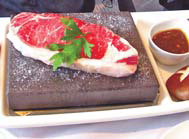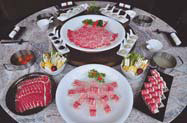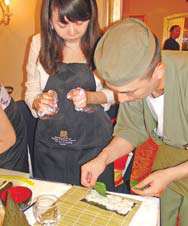Life and Leisure
Food Reviews
(China Daily)
Updated: 2010-09-27 16:13
 |
Large Medium Small |
Cooking stones

Making your own food often makes the food taste better. That's part of the attraction of Stonegrill, where you can cook your own beefsteaks and seafood on a hot slab of stone.
The first branch of the restaurant chain that serves food cooked on heated Australian volcanic stone has just opened in Beijing.
The dining process involves heating a slab of volcanic stone in an electric oven to 400 C, before placing it in front of the diner. If you are good at cooking now's the time to show off. Otherwise you can just ask a waitress to cook your beefsteak or seafood.
Watching your food sizzle on the stone does help whet the appetite. Owner, Beijinger Zhang Yao, says she chooses only the best ingredients for the grill: American chicken steak, Australian beef, rack of lamb, and Australian wagyu beef. The meats are paired with five different sauces including black pepper and mushroom, as well as seasonal vegetables.
The king tiger prawn, salmon, cod fish or scallop are priced from 158-218 yuan ($23.5-32.4) and are worth the price, and a seafood combo priced at 298 yuan is highly recommended, as it comprises tiger prawn, scallops, salmon and mussels. The meats are priced from 148 to 398 a piece. Beefsteaks weigh 170 or 200 g each.
The aubergine and mushrooms that accompany the meat are also tasty and help to degrease the meat. Moreover, the salads are beautifully presented.
Zhang says the chef comes from Peak Cafe Bar in Hong Kong, and also cooks good pizza and pasta. The restaurant has a selection of good wines, coffee and other drinks.
Daily 10 am-11pm. 1-09, Bldg 19, Wanda Square, 93 Jianguo Lu, Chaoyang district, Beijing. 010-5820-3269
Ye Jun
Hot pot in its element

There can hardly be a better time than autumn to open a hot pot restaurant, as the weather gets cool in Beijing and people start to seek comforting warming food. Xiang Yan Fusion Hot Pot restaurant is designed to take the interior decor and food quality of the capital's many hot pot eateries a step up the ladder.
Most customers will find the decor modern and comfortable. There is plenty of original wood, stone and glass, as well as gray and cream colors to create a natural and comfortable environment. Different areas are divided by glass.
The owners have designed "five elements" soups for the hot pots, which include yam and chicken with gold foil (metal), matsutake with assorted mushrooms (wood), Taiwan-style spicy soup (fire), floral mushroom and kelp clear soup (water), and tomato with pumpkin beef soup (earth). The five elements are said to be good for five corresponding organs in the body: lungs, liver, heart, kidney and spleen.
The eatery prepares pots for each person, placed in a hole inside the table. The pots are heated by replaceable tins of solidified alcohol, which last up to two hours. For set meals, foods are served Western cuisine style: starters, vegetable platter, meats, and dim sum.
Seafood includes mashed shrimp meatball, inkfish, lobster and even king crab. The shrimp meatballs have gold foil to make them more presentable. Fish meatballs have fish roes, providing an interesting crisp and chewy sensation.
To excel in quality meat, the restaurant provides Angus beef boneless ribs, as well as "snow dragon" beef, one of the best in China from Dalian, bred from Japanese wagyu. The restaurant's vegetarian combo looks colorful, and comprises a range of vegetables, mushrooms, corn, turnip, kelp and bean curd.
The average bill is around 200 yuan ($29.7) per person.
Daily 4 pm-2 am, Monday-Friday; 10 am-2 am, Saturday; 10 am-10:30 pm, Sunday. 2/F Guo'an Lou, opposite No 22 Platform, Workers' Stadium, enter from north gate, to the west side, near MIX, Chaoyang district, Beijing. 010-6553-8558
Ye Jun
Ins and outs of making sushi

Nothing is as simple as it looks. I was reminded of that at a sushi cooking class recently at Honzen Japanese Restaurant, Kempinski Hotel Beijing, where head chef Tani Gu shared his sushi-making skills and secrets.
Our instructions were simple enough: First, place a sheet of nori seaweed on a bamboo mat, with its top part aligned with the top of the mat. Then, spread out the glutinous rice, before placing various ingredients on it. Finally, just wrap it up and cut it into rolls. There's your sushi!
But I got stuck right from the start. The rice was so sticky that it kept binding to my fingers. This meant I couldn't place it neatly and evenly on the nori, which eventually led to a malformed piece of sushi.
I should have moistened my hands beforehand, I was told. I also had problem remembering all the steps involved. After the rice is placed on the nori, one needs to turn it over so the nori faces upwards, with the rice sticking to it on the outside, spread the grated cheese, and arrange the asparagus and ham on it.
Luckily, although my final work didn't look so good, it tasted nice. The ham, cheese and asparagus work nicely together for a rich flavor and texture.
Gu says the secret to making great sushi lies in using high-quality ingredients. For example, in California roll Gu uses only imported, short-grain rice. Instead of cucumber, Gu uses slices of lavender-colored Japanese eggplant, along with creamy, nutty avocado, which gives it a delightful texture. The class will conclude with a delicious four-course meal at Honzen. Cost is 398 yuan ($59) per person including recipe booklet.
4-7 pm, Sundays, Oct 17, Nov 14 and Dec 5. Honzen Japanese Restaurant, 1/F, Kempinski Hotel Beijing, 50 Liangmaqiao Road, Chaoyang district, Beijing. (010) 6465-3388 Ext 4220
Sun Li